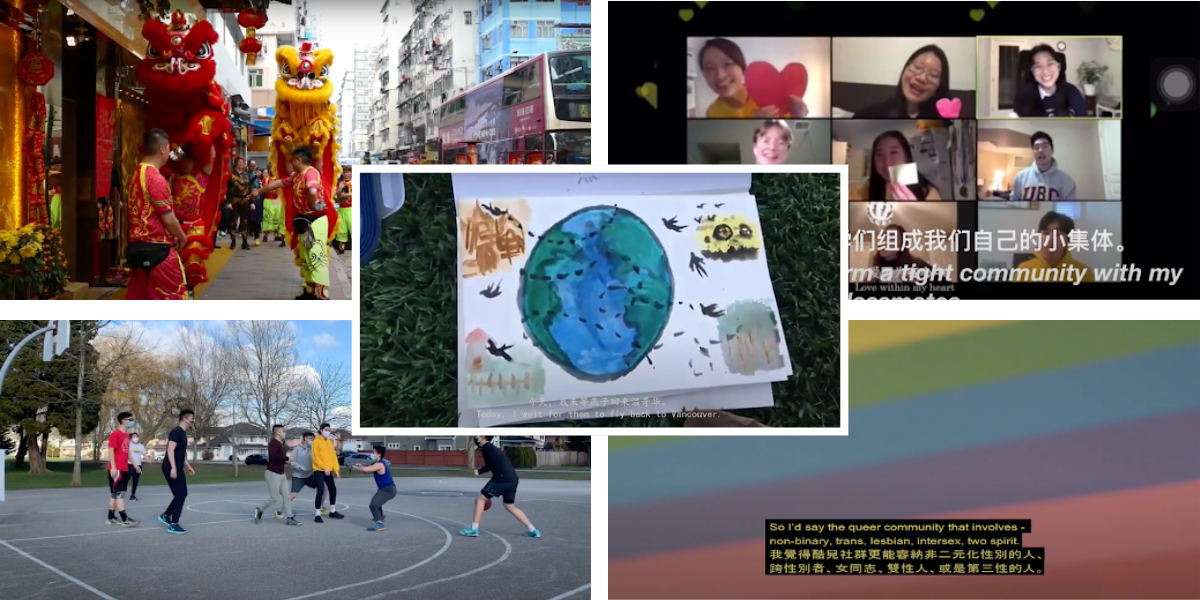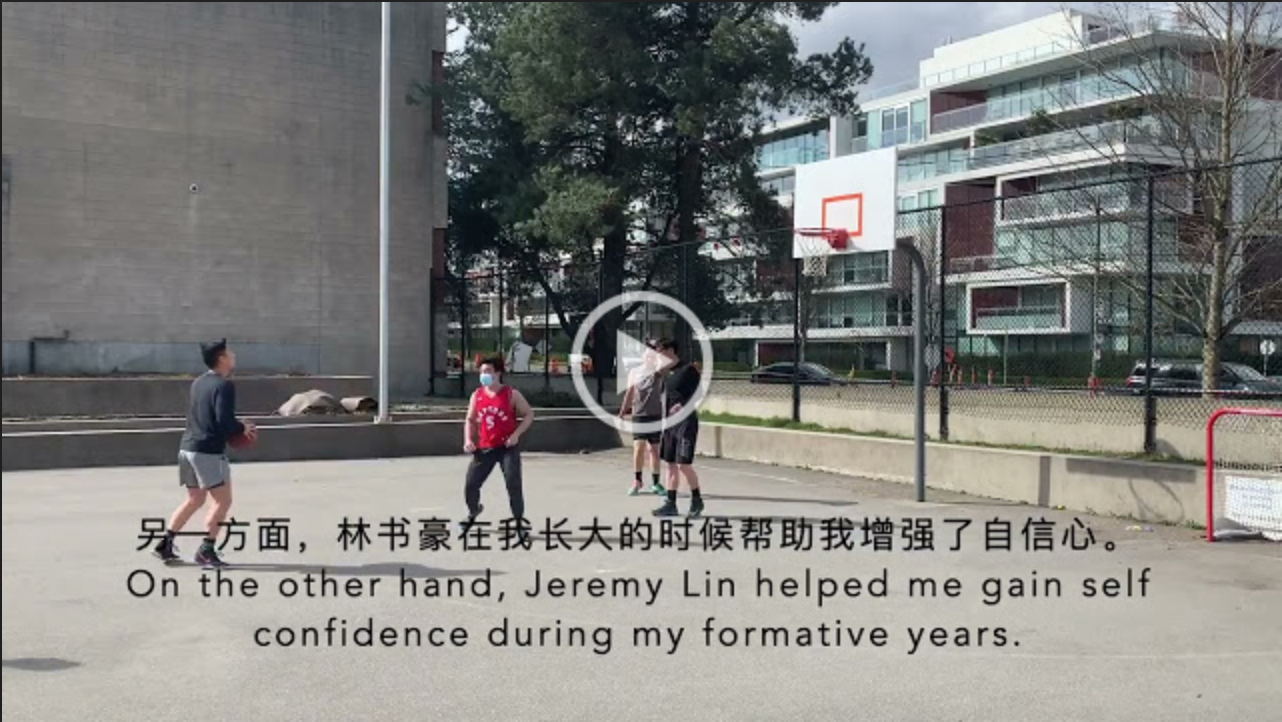
A heritage Chinese class can mean much more than teaching students linguistic skills, such as how to correctly pronounce words, or how to fluently formulate sentences. By encouraging the students to reflect on their own cultural heritage, CHIN 243: Basic Chinese II: Part 2 (Heritage) motivated them to further explore such significant concepts as equity, diversity, and inclusion (EDI). Through a heritage Chinese class like CHIN243, students not only become more aware of the various facets of their own identities, but also better prepared for extending the EDI concepts to their future experience in an increasingly globalized world. Via a series of exercises, CHIN243 prompted students to voice their heritage experience and bridge cultural as well as intergenerational gaps in ways that were truly unique and profound. As a CHIN 243 student said, “The Chinese class is not just a Chinese class, but an opportunity for me to know myself, my people and the world.” In a classroom that values and advocates for equity, diversity, and inclusion, CHIN 243 provides the students with a safe and supportive environment to explore, rethink, and even challenge their identities. This offers the students further opportunities to examine their thoughts on critical EDI issues in the classroom, school, and communities, even beyond what they may or may not have been aware of in their daily lives.
Furthermore, heritage Chinese classes such as CHIN243 create an incubating space that fosters heritage students’ proliferating ideas on what a diverse and inclusive community looks like. When asked to describe their heritage Chinese class, CHIN243 students came up with a cluster of creative comparisons. One student sees the class as a cup of bubble tea: “All mixed in a classroom environment, we are able to welcome and benefit from each other, becoming something special once we learn from each other.” Another says that, “I describe our class as a hot pot because many students come from different backgrounds. However, we are all similar in that we have the same culture and heritage. Much like a hot pot in which many different elements are added to one soup base, the elements represent the students whereas the soup represents the classroom and our culture.” Abundant with creativity, these metaphors bespeak the inclusive environment in a heritage Chinese class where students can demonstrate their own uniqueness and yet similarities. At the same time, these classes promote equity and diversity through students’ shared cultural heritage, as manifested in their inspiring projects below.
Inclusion
“The instructor … makes the effort to use inclusive language whenever possible.”
CHIN 243’s inclusive and supportive community helps heritage students understand the importance of making an effort to welcome and accept others in the widely diverse global society. It is through such openness that the whole community can learn how to listen to those who have been marginalized, stimulate conversations about cultures and identities, and foster a sense of belonging in a fastly globalizing world. These inclusive communities based on cultural heritage ultimately contribute to the celebration of differences around the world. As one CHIN243 student noted, “we are like hotpot! We are all different ingredients but [we] are also similar in many ways. Everyone is so warm and friendly to each other that makes the learning environment comfortable.”

Anna’s depiction of a globalizing world in her journal
In her final project, Anna, a second-year Global Resource Systems student from CHIN 243, points out that many heritage students like herself have migrated across the world along with their families. As a result, they all have highly diverse backgrounds. Anna’s own family come from England, the United States, and China. Such varied cultural backgrounds make her realize that heritage students may frequently struggle with establishing their own cultural identities. However, Anna states that, “I come from a different background from most of the class, and really valued getting to learn with and listen to this group, and explore my own identity with it. Heritage Chinese is much more than a language class. It’s about identity, heritage, culture, and our sense of belonging in all of it.” As Anna’s quote makes clear, heritage Chinese classes such as CHIN 243 have functioned as pivotal venues that help heritage students better understand where their cultural roots lie in a foreign land. CHIN 243 has proved that an inclusive class environment is essential to helping heritage learners feel comfortable in accepting their cultural roots. Anna notes further that, “I really appreciate the conversations we’re having around race and identity. I realize I come into the class with a lot of privilege for never having experienced discrimination for the way I look, so I’m also just grateful for the opportunity to hear my peers talk about this and what needs to change.” Accordingly, a heritage class’s inclusive conversations prove instrumental in promoting the articulation of BIPOC voices on such crucial issues as racism and discrimination.

Anna’s depiction of global migration in her journal
Anna’s Project: 燕宁一生的故事
Diversity
“[This class makes] an effort to emphasize the diversity within Chinese culture. One example of this was during our discussions about Guangdong Province, when the instructor encouraged students of Cantonese heritage to share their language and customs with others.”
In a heritage Chinese language classroom, such as that of CHIN 243, heritage students’ diverse identities, perspectives, and cultural backgrounds are celebrated. They are further encouraged to reflect on and challenge Western normative thinking. A CHIN243 student’s comparison vividly encapsulates the diversity inherent in the class: “We are like fried rice! Every ingredient is different and unique. But when mixed together, it looks and tastes better.” The final project of Jenny, a third-year English Honours CHIN 243 student, showcases the transformative potential of the diverse environment in a heritage Chinese language class. She recounts how immigrating to Canada from China made her feel alienated and isolated due to her initial inability to speak English. As a result, Jenny, in her formative years, tried to only speak English while shying away from her Chinese cultural roots. But her exclusive attention to Western cultures had rendered her constantly confused about her cultural identity. Through CHIN 243, however, Jenny increasingly realized that a Chinese class consisting of heritage students like herself could form a highly diverse environment teeming with cultural knowledge and perspectives alternative to western ones. Jenny recalls that, “whenever the opportunity arises, Wang Laoshi would incorporate both Chinese and English articles about current events and contemporary issues such as #stopasianhate for the class to explore and discuss.” Here, different perspectives are juxtaposed for heritage students to analyze so that they can critically think about social, cultural, and political issues in a more comprehensive way.

Jenny showcasing the richness of Chinese culture
Jenny’s Project: 说英文
Besides exposing them to diverse perspectives, CHIN243 also facilitates the students’ appreciation of gender diversity. In his final project, Tim, a fourth-year International Relations student from CHIN 243, expresses his initial frustration and confusion with the differing expectations of normative masculinity in Chinese and Western cultures. For instance, when playing basketball, Tim vividly felt the difference between Western society’s emphasis on strong physique and Chinese culture’s prioritization of academic excellence. He felt that, “in China, basketball focused on intelligence, skill and technique…after coming to Canada, I realized the competition got much fiercer. The players here were bigger, stronger and faster.” Through the diverse learning environment of CHIN243, Tim gradually learned to value the alternative views to normative thinking of gender notions and become reconciled with these contesting masculine ideals. Eventually, he decided to focus on collaboration, the true spirit of basketball, and always tries his best to support his teammates, like he always does in his Chinese class.

Tim’s supportive basketball community
Tim’s Project: 篮球浪漫
On the other hand, Alger, a fifth-year Visual Arts major, expressed the importance of foregrounding Asian and queer voices in his final project. By interviewing queer Asian Canadians, Alger aimed to make their conventionally marginalized voices heard across larger and wider communities. “I’ve felt alienated in spaces that are, you know, majority like white or straight. [That’s why] the people I hangout around are mostly Asian and queer, so I don’t really feel left out”, says Ricky Chan, a queer Asian man interviewed by Alger. Lyle Chan, another queer Asian interviewee of Alger, says he “finds community in the queer community… [because] it is all encompassing, and it involves non binary, trans, lesbian, intersex, two-spirit [and more].” The encouraging outlook on gender diversity Alger strives to bring out through his project accepts the gender minority as who they are and creates a strong sense of belonging for them.

Alger noticing how Asian queer communities embrace gender diversity
Alger’s Project: 同性华人的声音
Equity
“My peers are … very supportive of one another, no one is excluded from the learning process due to their identity, race, or sexuality.”
Heritage Chinese language classes such as CHIN 243 always seek to provide equal opportunities for each and every heritage learner, including those not yet proficient in Mandarin, to achieve their individual learning goals. For instance, the CHIN 243 classroom forms an equitable space where each heritage learner can share their own thoughts in an equal manner. Moreover, the concept of equity itself constituted a central topic for further discussion and reflection in class, as evidenced in the quote above by Kelly, a second-year International Relations student in CHIN243.
In her final project, Kelly explained that all of her classmates had experienced the same struggle of being detached from their own cultural heritage when growing up in a western society. It is precisely the shared experience that made the students feel very much inclined to treat each other equally with great help and support in their learning processes. Kelly further noticed that the class “truly acknowledges that we all come from different places and have different experiences as well as processes in learning Chinese, and caters to every one of us.”

Kelly’s tight-knit learning community in CHIN243
Moreover, the CHIN243 students were encouraged to articulate their own views on topics pertinent to equity during oral practice, such as the anti-racist #StopAsianHate campaign, historical mistreatments of Indegenous children in residential schools, and so forth. By discussing equity issues and reflecting on the concept itself, students become increasingly aware of similar issues in their own heritage communities. Thus, an equitable learning community like that of CHIN243 not only alerts students to potential inequalities, but more importantly, also helps fostering their empathy with those who have been conventionally discriminated against.
Kelly’s Project: 慢慢忘了我的母语
Celebrating students’ diverse cultural traditions, heritage Chinese language classes better equip heritage learners to cope with their multifaceted identities within a society where western norms still remain dominant. A deeper understanding of their varied cultural backgrounds not only empowers heritage learners, but also enables them to empower future generations to appreciate and celebrate their diversity across a wide range of contexts. Furthermore, by raising the awareness of Equity, Diversity and Inclusion (EDI), heritage Chinese classes make it possible for heritage learners to further foster EDI in the global community. In this sense, a heritage Chinese language class such as CHIN 243 kindles an EDI spark among students that will continue shining bright in the future.
Written by: Shih-wei Wang
Edited by: Erin Cheng
